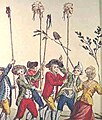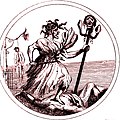
Oliver Cromwell was an English statesman, politician, and soldier, widely regarded as one of the most important figures in the history of the British Isles. He came to prominence during the 1639 to 1653 Wars of the Three Kingdoms, initially as a senior commander in the Parliamentarian army and latterly as a politician. A leading advocate of the execution of Charles I in January 1649, which led to the establishment of The Protectorate, he ruled as Lord Protector from December 1653 until his death in September 1658. Cromwell remains a controversial figure due to his use of the army to acquire political power, and the brutality of his 1649 campaign in Ireland.
Posthumous execution is the ritual or ceremonial mutilation of an already dead body as a punishment. It is typically performed to show that even in death, one cannot escape justice.
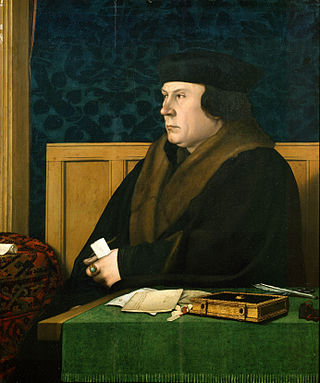
Thomas Cromwell, briefly Earl of Essex, was an English statesman and lawyer who served as chief minister to King Henry VIII from 1534 to 1540, when he was beheaded on orders of the king, who later blamed false charges for the execution.

A pike is a long thrusting spear formerly used in European warfare from the Late Middle Ages and most of the early modern period, and wielded by foot soldiers deployed in pike square formation, until it was largely replaced by bayonet-equipped muskets. The pike was particularly well known as the primary weapon of Swiss mercenary, German Landsknecht units and French sans-culottes. A similar weapon, the sarissa, had been used in antiquity by Alexander the Great's Macedonian phalanx infantry.

London Bridge refers to several historic crossings that have spanned the River Thames between the City of London and Southwark, in central London since Roman times. The current crossing, which opened to traffic in 1973, is a box girder bridge built from concrete and steel. It replaced a 19th-century stone-arched bridge, which in turn superseded a 600-year-old stone-built medieval structure. In addition to the roadway, for much of its history, the broad medieval bridge supported an extensive built up area of homes and businesses part of the City's Bridge Ward and its southern end in Southwark was guarded by a large stone City gateway. The medieval bridge was preceded by a succession of timber bridges, the first of which was built by the Roman founders of London (Londinium) around 50 AD.

Thornbury is a market town and civil parish in the South Gloucestershire unitary authority area of England, about 12 mi (19 km) north of Bristol. It had a population of 12,063 at the 2011 census. The population has risen to 14,496 in the 2021 census. Thornbury is a Britain in Bloom award-winning town, with its own competition: Thornbury in Bloom. The earliest documentary evidence of a village at "Thornbyrig" dates from the end of the 9th century. The Domesday Book of 1086 noted a manor of "Turneberie" belonging to William the Conqueror’s consort, Matilda of Flanders, with 104 residents.
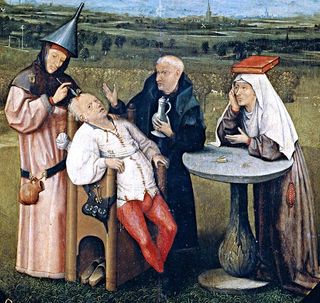
Trepanning, also known as trepanation, trephination, trephining or making a burr hole, is a surgical intervention in which a hole is drilled or scraped into the human skull. The intentional perforation of the cranium exposes the dura mater to treat health problems related to intracranial diseases or release pressured blood buildup from an injury. It may also refer to any "burr" hole created through other body surfaces, including nail beds. A trephine is an instrument used for cutting out a round piece of skull bone to relieve pressure beneath a surface.

Impalement, as a method of torture and execution, is the penetration of a human by an object such as a stake, pole, spear, or hook, often by the complete or partial perforation of the torso. It was particularly used in response to "crimes against the state" and regarded across a number of cultures as a very harsh form of capital punishment and recorded in myth and art. Impalement was also used during times of war to suppress rebellions, punish traitors or collaborators, and punish breaches of military discipline.
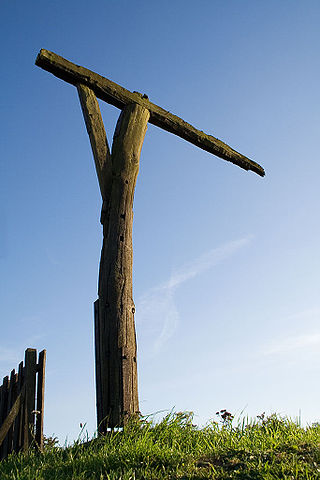
A gibbet is any instrument of public execution. Gibbeting is the use of a gallows-type structure from which the dead or dying bodies of criminals were hanged on public display to deter other existing or potential criminals. Occasionally, the gibbet was also used as a method of execution, with the criminal being left to die of exposure, thirst and/or starvation. The practice of placing a criminal on display within a gibbet is also called "hanging in chains".

Vlad III, commonly known as Vlad the Impaler or Vlad Dracula, was Voivode of Wallachia three times between 1448 and his death in 1476/77. He is often considered one of the most important rulers in Wallachian history and a national hero of Romania.
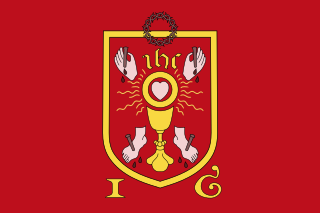
The Pilgrimage of Grace was a popular revolt beginning in Yorkshire in October 1536, before spreading to other parts of Northern England including Cumberland, Northumberland, Durham and north Lancashire, under the leadership of Robert Aske. The "most serious of all Tudor period rebellions", it was a protest against Henry VIII's break with the Catholic Church, the dissolution of the lesser monasteries, and the policies of the King's chief minister, Thomas Cromwell, as well as other specific political, social, and economic grievances.

John Bradshaw was an English jurist. He is most notable for his role as President of the High Court of Justice for the trial of King Charles I and as the first Lord President of the Council of State of the English Commonwealth.

The Storming of the Bastille occurred in Paris, France, on 14 July 1789, when revolutionary insurgents attempted to storm and seize control of the medieval armoury, fortress and political prison known as the Bastille. After four hours of fighting and 94 deaths the insurgents were able to enter the Bastille. The governor de Launay and several members of the garrison were killed after surrender. The Bastille then represented royal authority in the centre of Paris. The prison contained only seven inmates at the time of its storming and was already scheduled for demolition, but was seen by the revolutionaries as a symbol of the monarchy's abuse of power. Its fall was the flashpoint of the French Revolution.
Count Redmond O'Hanlon, was a 17th-century Irish tóraidhe or rapparee; an outlawed member of the Gaelic nobility of Ireland who still held to the code of conduct of the traditional chiefs of the Irish clans.
"Éamonn an Chnoic" is a popular Sean nos song in traditional Irish music. It is a slow, mournful ballad with a somber theme and no chorus.
Events from the 1530s in England.

Catherine Howard, also spelt Katheryn Howard, was Queen of England from 1540 until 1541 as the fifth wife of King Henry VIII. She was the daughter of Lord Edmund Howard and Joyce Culpeper, a cousin to Anne Boleyn, and the niece of Thomas Howard, 3rd Duke of Norfolk. Thomas Howard was a prominent politician at Henry's court, and he secured her a place in the household of Henry's fourth wife, Anne of Cleves, where she caught the King's interest. She married him on 28 July 1540 at Oatlands Palace in Surrey, just 19 days after the annulment of his marriage to Anne. He was 49, and she was between 15 and 21 years old, though it is widely accepted that she was 17 at the time of her marriage to Henry VIII.

Oliver Cromwell, Lord Protector and ruler of the English Commonwealth after the defeat and beheading of King Charles I during the English Civil War, died on 3 September 1658 of natural causes. He was given a public funeral at Westminster Abbey equal to those of the monarchs who came before him. His position passed to his son Richard, who was overthrown shortly afterwards, leading to the re-establishment of the monarchy.
The use of impalement in myth, art, and literature includes mythical representations of it as a method of execution and other uses in paintings, sculptures, and the like, folklore and other tales in which impalement is related to magical or supernatural properties, and the use of simulated impalement for the purposes of entertainment.
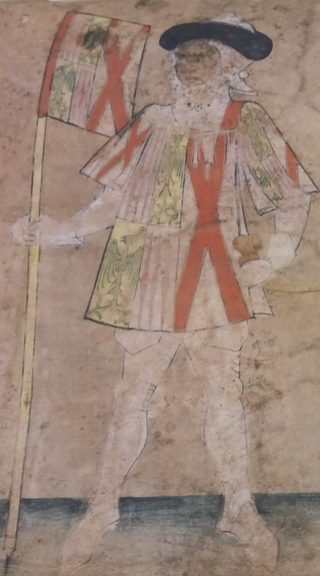
Sir Thomas Neville was the second son of Richard Neville, 5th Earl of Salisbury, a major nobleman and magnate in the north of England during the fifteenth-century Wars of the Roses, and a younger brother to the more famous Richard Neville, Earl of Warwick, the 'Kingmaker'. Thomas worked closely with them both in administering the region for the Crown and became a significant player in the turbulent regional politics of northern England in the early 1450s, especially in the Neville family's growing local rivalry with the House of Percy. His wedding in August 1453 is said to have marked the beginning of the armed feud between both houses, in which Thomas and his brother John led a series of raids, ambushes and skirmishes across Yorkshire against the Percy family. Historians describe the feud as setting the stage for the Wars of the Roses, the dynastic struggle between the houses of Lancaster and York for the English throne, and Thomas played a large role in the Neville family's alliance with his uncle, Richard, Duke of York.


